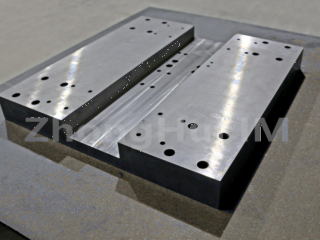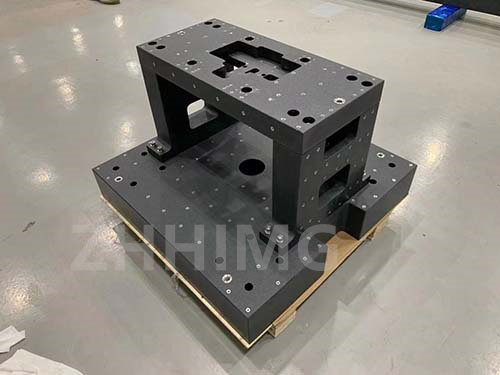In the application of ultra-precision motion module, the base, as a key supporting component, plays a decisive role in the performance of the module. Granite precision base and cast base have their own characteristics, and the contrast between them is obvious.
I. Stability
Granite after millions of years of geological changes, the internal structure is dense and uniform, mainly by quartz, feldspar and other minerals closely combined. This unique structure gives it excellent stability and can effectively resist external interference. In the electronic chip manufacturing workshop, the peripheral equipment runs frequently, and the granite base can reduce the vibration amplitude of the ultra-precision motion module transmitted to the air float by more than 80%, ensuring the smooth movement of the module and providing a solid guarantee for the high-precision processes such as lithography and etching of chip manufacturing.
Although the casting base can buffer vibration to a certain extent, there may be some defects such as sand holes and pores in the casting process, which will reduce the uniformity and stability of the structure. In the face of high-frequency and high-strength vibration, the vibration attenuation ability is not as good as granite base, resulting in poor motion stability of the ultra-precision motion module of the air float, which affects the processing and detection accuracy of the equipment.
Second, accuracy retention
Granite thermal expansion coefficient is very low, generally in 5-7 ×10⁻⁶/℃, in the temperature fluctuation environment, the size change is minimal. In the field of astronomy, the ultra-precision motion module for the fine-tuning of the telescope lens is paired with the granite base, even if the temperature difference between day and night is large, it can ensure that the positioning accuracy of the lens is maintained at the sub-micron level, helping astronomers to clearly observe distant celestial bodies.
Casting base commonly used metal materials, such as cast iron, thermal expansion coefficient is relatively high, about 10-20 ×10⁻⁶/℃. When the temperature changes, the size changes obviously, which is easy to cause thermal deformation of the ultra-precision motion module of the air float, resulting in a decrease in motion accuracy. In the temperature-sensitive optical lens grinding process, the deformation of the cast base under the influence of temperature may cause the deviation of the lens grinding precision beyond the allowable range and affect the lens quality.
Third, wear resistance
Granite hardness is high, Mohs hardness can reach 6-7, strong wear resistance. In the materials science laboratory, the frequently used air float ultra-precision motion module, granite base can effectively resist the friction of the air float slider, compared with the ordinary cast base, can extend the maintenance cycle of the module by more than 50%, reduce equipment maintenance costs, and ensure the continuity of scientific research work.
If the casting base is made of ordinary metal materials, the hardness is relatively low, and the surface is easy to wear under the long-term reciprocating friction of the air float slider, which affects the motion accuracy and smoothness of the ultra-precision motion module of the air float, requiring more frequent maintenance and replacement, increasing the use cost and downtime.
Fourth, manufacturing cost and processing difficulty
Granite raw material acquisition cost is high, mining, transportation complex, processing requires professional equipment and technology, such as high-precision cutting, grinding, polishing, etc., high manufacturing costs. And because of its high hardness, brittleness, processing difficulty, easy to appear edge collapse, cracks and other defects, scrap rate is high.
The casting base raw materials are widely sourced, the cost is relatively low, the casting process is mature, the processing difficulty is small, and the mass production can be carried out through the mold, with high production efficiency and controllable cost. However, to achieve the same high precision and stability as the granite base, the casting process and post-processing requirements are extremely strict, and the cost will also rise significantly.
In summary, granite precision base has a significant advantage in the application scenarios of ultra-precision motion modules with high accuracy, stability and wear resistance. The casting base has certain advantages in cost and processing convenience, and is suitable for occasions where the accuracy requirement is relatively low and the pursuit of cost efficiency is pursued.
Post time: Apr-08-2025


